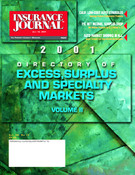There are three kinds of cell phone users: Type 1 is a Non-User—they may have one, but it is rarely turned on, often left at home, mainly existing for emergencies. Type 2 is a Moderate User—they keep it close by and use it to call the spouse from traffic, call the client before a meeting.
Then there’s Type 3: the Cell Phone Addict. This last is dangerous—they are physically attached to their phones. They shrug off theories that overuse of cell phones can cause cancer like sun worshipers scoff at SPF 45. Take their phone out of service, and panic sets in.
Insurance professionals tend to land somewhere between Type 2 and Type 3. It’s a rare conference or association luncheon that someone’s cell doen’t start shrilling “Für Elise,” causing everyone in the room to involuntarily grab for their phone.
But even the most shameless Cell Phone Addicts agree on one thing: they can be dangerous on the road. According to a survey by the Insurance Research Council, 91 percent of Americans believe that the use of cell phones while driving distracts drivers and increases the likelihood of accidents. (Think about the last time you did something more complicated than folding laundry while talking on the phone at home.)
And yet, drivers report that their cell use has continued to increase, and cell phone sales have doubled in the last three years, adding up to 10 million units in California alone.
Jeff Case, broker with Gray-Stone & Company in Stockton, Calif., said he uses his cell phone “a lot—approximately 1,400 minutes per month.” “I think it probably does cause distractions, so I have all my numbers speed-dialed in and use a hands-free speaker device.”
Fortunately for the Cell Addicted, these “hands-free” options are becoming more prevalent, and cheaper as well (most run around $20).
Dave Mathews, vice president of Pritchard & Jerden Inc. Insurance and Risk Management in Atlanta, is also a proponent of hands-free. “Just a few weeks ago, I watched as a driver on their (gender deleted!) cell phone rear-ended another car. The driver had plenty of room to stop, but was so intent on the conversation, did not see the other vehicle until it was too late. Luckily, no one was injured.”
So, if drivers using cell phones cause accidents—thereby increasing claims and pushing up premiums—do we follow New York’s example and ban them in every state?
According to the IRC study, most of the public (69 percent) would support a law to ban cell phone use while driving. “My guess is that it’s just a matter of time before California jumps on the NY bandwagon as far as enacting new legislation,” Case said.
Other states may soon follow suit. In the meantime, all you Cell Phone Addicts: let’s try to keep both hands on the wheel.
Was this article valuable?
Here are more articles you may enjoy.


 High-Net-Worth Risk Appetite Drops as Some Regions Show Stabilization
High-Net-Worth Risk Appetite Drops as Some Regions Show Stabilization  Howden US Tells Judge Brown & Brown Employees Fled Due to ‘Mistreatment’
Howden US Tells Judge Brown & Brown Employees Fled Due to ‘Mistreatment’  Florida Insurance Agency VP Sentenced to 3 Years in Massive ACA Fraud Scheme
Florida Insurance Agency VP Sentenced to 3 Years in Massive ACA Fraud Scheme  MAPFRE Accuses AAA of Violating Long-Time Exclusive Marketing Agreement
MAPFRE Accuses AAA of Violating Long-Time Exclusive Marketing Agreement 


